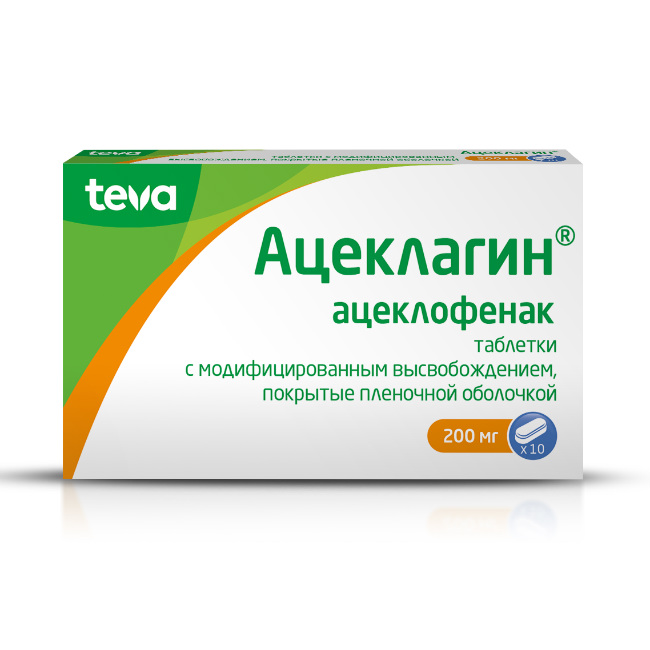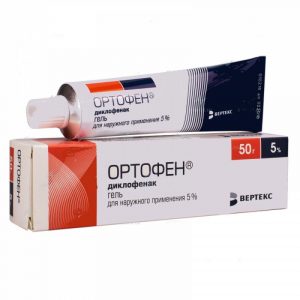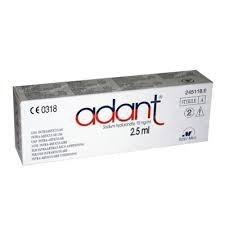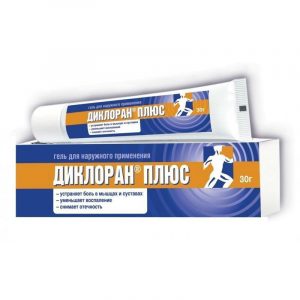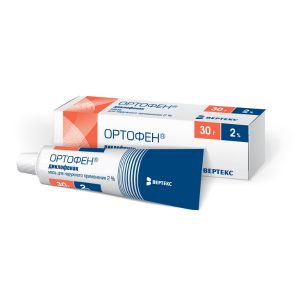Description
Release form
200 mg film-coated tablets.
10 tablets per blister of PVDC / aluminum foil. 1, 3 or 10 blisters with instructions for use in a cardboard box.
Pharmacological action of
Pharmacotherapeutic group: non-steroidal anti-inflammatory drug (NSAID)
Code ATC: M01AB16
Pharmacological properties of
Pharmacodynamics
Aceclofenac has anti-inflammatory, analgesic and analgesic effects. It inhibits the synthesis of prostaglandids and. Thus, it affects the pathogenesis of inflammation, the onset of pain and fever. In rheumatic diseases, the anti-inflammatory and analgesic effect of aceclofenac significantly reduces the severity of pain, morning stiffness, swelling of the joints, which improves the patient s functional state.
Pharmacokinetics
Absorption.
After oral administration, aceclofenac is rapidly absorbed. The maximum concentration (Cmax) in the blood plasma is reached 1.25-3 hours after ingestion. Eating slows down absorption, but does not affect its degree.
distribution.
Aceclofenac is highly bound to plasma proteins (> 99.7%). Aceclofenac penetrates into the synovial fluid, where its concentration reaches 60% of its concentration in blood plasma. The volume of distribution is 30 liters. Metabolism. Aceclofenac is believed to be metabolized by the CYP2C9 isoenzyme to form a 4-OH-aceclofenac metabolite. Diclofenac and 4-OH-diclofenac are among the numerous metabolites of aceclofenac.
Withdrawal.
The average elimination half-life (Ti / g) when taking modified release tablets is about 5 hours. Ground clearance is 5 l / h. Approximately 2/3 of the dose taken is excreted by the kidneys, mainly in the form of conjugated hydroxymetabolites. Only 1% of the dose after oral administration is excreted unchanged.
Indications
Relief of inflammation and pain syndrome with lumbago, toothache, shoulder-shoulder periarthritis, rheumatic soft tissue lesions, for the symptomatic treatment of rheumatoid arthritis, osteoarthritis and ankylosing spondylitis.
Symptomatic therapy, reduction of pain and inflammation at the time of use, does not affect the progression of the disease.
Dysmenorrhea.
Contraindications
Hypersensitivity to aceclofenac or auxiliary components of the drug
bronchospasm, rhinitis or urticaria after taking acetylsalicylic acid or other NSAIDs in the history (full or incomplete syndrome of intolerance to the coronary artery lacrimonitis, mucosa, rhinosa erosive and ulcerative lesions of the mucous membrane of the gastrointestinal tract (GIT) in the exacerbation phase (including ulcerative colitis, Crohn’s disease)
gastrointestinal tract chnoe bleeding or suspected him
severe heart failure (II-IV class according to the classification of New York Heart Association), coronary heart disease, diseases of the peripheral arteries and / or arteries of the brain
period after coronary artery bypass grafting
severe liver failure or active liver disease
severe renal failure (creatinine clearance <30 ml / min), progressive kidney disease, confirmed hyperkalemia of pregnancy and lactation children under 18 years of age. With caution History of liver, kidney and gastrointestinal diseases, bronchial asthma, hypertension, decreased circulating blood volume (including after extensive surgery), coronary heart disease, chronic renal and hepatic and heart failure, creatinine clearance less than 60 ml / min, a history of gastrointestinal ulcerative lesions, the presence of Helicobacter pylori infection, dyslipidemia / hyperlipidemia, diabetes mellitus, smoking, old age, prolonged use of NSAIDs, severe somatic diseases, alcoholism. Pregnancy and lactation Pregnancy Aceclagin ® is contraindicated in pregnancy. Information on the use of aceclofenac during pregnancy is not available. Inhibition of prostaglandin synthesis may adversely affect pregnancy and / or embryo / fetal development. During the third trimester of pregnancy, all inhibitors of prostaglandin synthesis: , having cardiopulmonary toxicity, can cause premature closure of the Botallus duct with the development of pulmonary hypertension can cause fetal renal failure, which can progress to renal failure in combination with polyhydramnios. In late pregnancy: may affect bleeding duration due to antiplatelet effect. which can develop even after the application of very low doses of , the drug can suppress uterine contractions, leading to delayed labor or prolonged labor. Breastfeeding period The drug should not be taken during breastfeeding. There are no data on the allocation of aceclofenac with human milk. In preclinical studies with the introduction of radioactive C-aceclofenac, a marked transfer of radioactivity into milk was not observed. Fertility Nonsteroidal anti-inflammatory drugs (NSAIDs) can affect fertility and are not recommended for use by women planning a pregnancy. Special instructions The simultaneous administration of Aceclaginum and other NSAIDs, including selective cyclooxygenase-2 (COX-2) inhibitors, should be avoided. Adverse events can be minimized by applying the minimum effective dose and reducing the duration of treatment needed to control symptoms. Effect on the gastrointestinal tract Bleeding, ulcer or perforation of the gastrointestinal tract with a fatal outcome was observed when taking any NSAIDs at any period of treatment, as in the presence of the corresponding symptoms and the presence of serious gastrointestinal diseases in the anamnesis (gastric and duodenal ulcer, Crohn’s disease, ulcerative colitis and etc.), and without them. The risk of bleeding, ulceration and perforation of the gastrointestinal tract increases with an increase in the dose of NSAIDs in patients with a history of peptic ulcer, especially if it was accompanied by bleeding or perforation, as well as in elderly patients. These patients should take the minimum effective dose. Consideration should be given to the use of combination therapy with protective drugs (for example, misoprostol or proton pump inhibitors). Such treatment is necessary for patients who take small doses of aspirin or other drugs that adversely affect the state of the gastrointestinal tract. Patients with gastrointestinal diseases, including the elderly, must report any unusual symptoms associated with the gastrointestinal tract (especially bleeding), including when taking the drug for the first time. Particular care should be taken in patients taking drugs at the same time, which may increase the risk of bleeding or ulcers, such as systemic corticosteroids, anticoagulants (such as warfarin), selective serotonin reuptake inhibitors, or antiplatelet agents (such as acetylsalicylic acid). If gastrointestinal bleeding or ulcers occur in patients taking Aceclagin ®, treatment should be discontinued. Cases of drug pancreatitis are rare. However, cases of pancreatitis have been reported in association with NSAIDs. Effects on the cardiovascular and central nervous system Patients with mild or moderate arterial hypertension and / or congestive heart failure need appropriate monitoring, as fluid retention and edema are associated with NSAIDs. Aceclofenac is structurally similar to diclofenac and has a similar metabolism. For diclofenac, there is evidence of an increased risk of thromboembolic complications (e.g., myocardial infarction or stroke, in particular with long-term treatment with high doses). There is also an increased risk of developing acute coronary syndrome associated with aceclofenac. Patients with chronic heart failure (class I according to the classification of the New York Cardiac Association) and patients with risk factors for complications of the cardiovascular system (e.g. arterial hypertension, diabetes mellitus, smoking) should begin treatment with aceclofenac only after a informed decision by the doctor. Risks from the cardiovascular system may depend on the dose and duration of treatment, therefore, the drug should be prescribed in the minimum effective dose and for the shortest possible period of time. Effect on the liver and kidneys NSAIDs may cause a dose-dependent decrease in prostaglandin formation and acute renal failure. The importance of prostaglandins to ensure renal blood flow should be considered when taking Aceclagin in patients with impaired heart, kidney or liver function, in patients receiving diuretics, or in patients after surgery, as well as in elderly patients. Caution should be exercised when using the drug Aceclagin in patients with impaired liver and kidney function of mild or moderate severity, as well as in patients with other conditions predisposing to fluid retention in the body. In such patients, the use of NSAIDs can lead to impaired renal function and fluid retention. In patients taking diuretics, people with an increased risk of hypovolemia, caution should also be exercised when taking Aceclaginum. It is necessary to use the minimum effective dose and regular medical monitoring of kidney function. Adverse events from the kidneys are usually resolved after ceasing taking aceclofenac. Aceclagin should be discontinued if changes in liver function indicators persist or worsen, clinical signs or symptoms of liver diseases develop, or other manifestations occur (eosinophilia, skin rash). Hepatitis can develop without prodromal symptoms. NSAIDs in patients with hepatic porphyria can trigger an attack. Hypersensitivity and skin reactions Like other NSAIDs, aceclofenac can cause allergic reactions, including anaphylactic / anaphylactoid reactions, even if aceclofenac is taken for the first time. Severe skin reactions (some of which can be fatal), including exfoliative dermatitis, Stevens-Johnson syndrome and toxic epidermal necrolysis, have been very rare after taking NSAIDs. The highest risk of these reactions in patients is observed at the beginning of taking aceclofenac, and the development of these adverse reactions is observed during the first month of taking aceclofenac. If you experience a skin rash, damage to the oral mucosa, or other signs of hypersensitivity, you should stop taking Aceclagin. In some cases, chickenpox can cause infections of the skin and soft tissues. Currently, the role of NSAIDs in worsening the course of these infections cannot be ruled out. Therefore, you should avoid taking Aceclaginum with chickenpox. Hematologic disorders Aceclofenac may cause reversible inhibition of platelet aggregation. Respiratory system disorders Caution should be exercised when taking Aceclaginum in patients with bronchial asthma (including a history), since taking NSAIDs can provoke the development of sudden bronchospasm in such patients. Elderly patients Caution should be exercised when taking Aceclaginum in elderly patients, as they often experience side effects (especially bleeding and perforation of the gastrointestinal tract) when taking NSAIDs. Complications can be fatal. Also, elderly patients are more likely to suffer from diseases of the kidneys, liver, or cardiovascular system. Long-term use of All patients receiving long-term NSAID treatment, should be closely monitored (for example, a complete blood count, functional liver and kidney tests). Due to the antiprostaglandin properties of NSAIDs. caution should be recommended to women taking mifepristone, since when combined with NSAIDs, a decrease in the effectiveness of the drug can theoretically occur. Clinical relevance unknown. Influence on the ability to drive vehicles and mechanisms You should refrain from driving vehicles and engaging in other potentially dangerous activities that require an increased concentration of attention and speed of psychomotor reactions, since the drug may cause dizziness and other side effects that may affect these abilities . Composition of 1 tablet contains: active substance aceclofenac 200.0 mg excipients: microcrystalline cellulose 159.5 mg, povidone-KZO 19.5 mg, croscarmellose sodium 9.7 mg, sodium stearyl fumarate 40.37 4 poloxam 5 mg. hypromellose 40.5 mg, carbomer 941 2.5 mg. Shell composition: Opadry white OY-C-7000 A 12.0 mg: hypromellose 5cP (E464) 54.850%, titanium dioxide (E 171) 22.860%. USP ethyl cellulose 13.720%), diethyl phthalate 8.570%. Dosage and Administration Inside. The tablets should be swallowed whole with plenty of water. The recommended daily dose for adults is 200 mg with a single dose (1 tablet per day). Side effects The following are adverse events, information about which was obtained in clinical trials and during post-marketing surveillance. The frequency of development of adverse events is classified as follows: very often (? 1/10) often (from? 1/100 to <1/10) infrequently (from? 1/1000 to <1/100), rarely (from? 1/10000 to <1/1000), very rarely (<1/10000). From the blood and lymphatic system: rarely – anemia is very rare – inhibition of bone marrow function, granulocytopenia, thrombocytopenia, neutropenia, hemolytic anemia. On the part of the immune system: rarely – anaphylactic reactions, including shock, hypersensitivity. From the side of metabolism and nutrition: very rarely – hyperkalemia, weight gain. From the psyche: very rarely – depression, unusual (atypical) dreams, insomnia. From the nervous system: often – dizziness is very rare – paresthesia, tremor, drowsiness, headache, dysgeusia (taste perversion). From the side of the organ of vision: rarely – visual impairment. On the part of the organ of hearing and the labyrinth: very rarely – vertigo, tinnitus. From the side of the heart: rarely – heart failure is very rare – heart palpitations. From the vessels: rarely – increased blood pressure, worsening of hypertension very rarely – flushing of the skin, hot flashes (short-term sensation of heat, accompanied by sweating), vasculitis. From the respiratory system, chest and mediastinal organs: rarely – shortness of breath very rarely – bronchospasm. From the gastrointestinal tract: often – dyspepsia, abdominal pain, nausea, diarrhea infrequently – flatulence, gastritis, constipation, vomiting, ulceration of the oral mucosa rarely – melena, ulceration of the mucous membrane of the gastrointestinal tract, hemorrhagic diarrhea, hemorrhage of the mucous membrane of the gastrointestinal tract is very rare – stomatitis, vomiting of blood, perforation of the intestine, worsening of Crohn s disease and ulcerative colitis, pancreatitis. From the side of the liver and biliary tract: often – increased activity of liver enzymes is very rare – liver damage (including hepatitis), increased activity of alkaline phosphatase. From the skin and subcutaneous tissue: infrequently – itching. rash, dermatitis, urticaria rarely – angioedema is very rare – purpura, eczema, severe reactions from the skin and mucous membranes (including Stevens-Johnson syndrome and toxic epidermal necrolysis). In some cases, serious skin infections and soft tissue infections were observed when taking NSAIDs during chickenpox. From the kidneys and urinary tract: infrequently – increasing the concentration of urea and creatinine in the blood serum is very rare – nephrotic syndrome, renal failure. Systemic disorders and complications at the injection site: very rarely – edema, fatigue, muscle cramps of the lower extremities. If the patient has noted a worsening of any of the listed adverse events or an adverse event not listed in this manual, he should contact his doctor. Overdose There is no evidence of an overdose of aceclofenac in humans. Possible symptoms: nausea, vomiting, pain in the stomach, dizziness, headache, hyperventilation with increased convulsive readiness. Treatment: gastric lavage, intake of activated carbon, symptomatic therapy. Forced diuresis, hemodialysis is not effective enough. Storage conditions Do not store above 30 ° C. Keep out of the reach and sight of children. Expiration 2 years. active substance Aceclofenac Medication conditions Pharmacies In retseptu The dosage form of tablet
